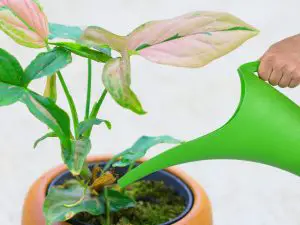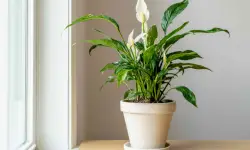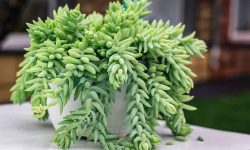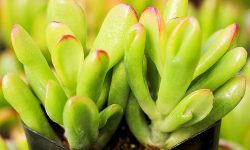An arrowhead plant is also known as Syngonium plant. It is the most popular houseplant with dark-green spade-shaped leaves that mark a bold statement in the indoor space. If you want to get one or more, you need to know how often to water arrowhead plant.
We recommend watering arrowhead plant every 10-14 days. But you need to test the soil moisture level before watering your favorite houseplant. The technique will help to avoid overwatering and underwatering problems associated with caring for arrowhead plants.
This article provides detailed insights into factors affecting arrowhead plant watering and techniques of watering your houseplant. Take the time to read through first and implement the tricks highlighted.

Factors That Influence Arrowhead Plant Watering
Arrowhead plant water requirement is highly influenced by external factors. These factors determine how often you need to water your indoor syngonium plants. Let’s find out now:
Sunlight
Sunlight plays a crucial role in determining the watering frequency of an arrowhead plant (Syngonium podophyllum). These plants thrive in bright, indirect light.
When it comes to watering, the amount of sunlight the plant receives affects its water requirements. Increased sunlight exposure results in faster transpiration, causing the plant to lose more moisture.
To maintain the optimal watering frequency for your arrowhead plant, monitor the soil moisture regularly. Water the plant when the top inch of the soil feels dry to the touch.
In sunnier conditions, the soil may dry out more quickly, requiring more frequent watering. Avoid overwatering as it can lead to root rot.
Adjust the watering schedule based on the specific sunlight conditions in your environment. The trick will help to avoid overwatering and underwatering issues.
Temperature
Temperature influences the watering needs of an arrowhead plant. Warmer temperatures accelerate the rate of evaporation and transpiration, causing the plant to lose moisture more rapidly.
Higher temperatures also increase the plant’s overall metabolic activity, which can result in faster water uptake and utilization. Consider the temperature of your houseplant surroundings.
In warmer climates or during the summer months, the plant may require more frequent watering. Conversely, in cooler temperatures or during the winter, the plant’s water requirements decrease.
Be sure to feel 2-3 inches of topsoil before watering your indoor arrowhead plant regardless of the temperature. This is the golden rule to foster healthy growth and well-being of the plant.
Humidity
Humidity levels significantly impact the watering frequency of arrowhead plants. These plants thrive in moderate to high humidity environments.
Higher humidity helps retain moisture in the soil and reduces the rate of water loss through transpiration. Low humidity will make the soil to dry quickly requiring more frequent watering.
In humid conditions, the soil retains moisture for a longer period, reducing the frequency of watering. Consider using a humidifier to increase humidity levels around the plant.
Regularly misting the leaves can also help maintain adequate humidity. But we do not recommend this method since it could lead to arrowhead plant leaf problems.
Pot Size
The size of the pot affects the watering frequency of an arrowhead plant. Larger pots typically retain more moisture than smaller ones, leading to slower soil drying. This means that plants in larger pots generally require less frequent watering compared to those in smaller pots.
Choose a pot size that is appropriate for the size of your arrowhead plant, allowing room for root growth. Ensure the pot has drainage holes to prevent waterlogging. When watering, be mindful of the pot size, as it can impact how quickly the soil dries out.
Potting Soil
The type of potting soil used for your arrowhead plant can influence its watering frequency. Well-draining soil is crucial for these plants to prevent waterlogged roots, as they are susceptible to root rot.
A well-draining soil mix allows excess water to flow out of the pot, promoting healthy root growth and preventing moisture-related issues. When watering your arrowhead plant, choose a potting mix specifically formulated for houseplants.
Such a mix ensures good drainage while retaining adequate moisture. Avoid heavy or compacted soils, as they can retain water for longer periods, leading to overwatering and root rot.
How Often to Water Arrowhead Plant
Caring for arrowhead plants (Syngonium podophyllum) involves various aspects, and one critical element is proper watering. The frequency with which you water your arrowhead plant plays a crucial role in its overall health and well-being.
Arrowhead plants prefer consistently moist soil, but overwatering can lead to root rot and other problems. The key is to maintain a balance that allows the soil to dry slightly between waterings. This ensures that the roots receive adequate oxygen while preventing waterlogged conditions.
Determining the ideal watering frequency for your arrowhead plant involves a combination of observation and knowledge. You need to check the moisture content of 2-3 inches of topsoil. If it feels dry to the touch, it is usually an indication that watering is necessary.
If the soil still retains some moisture, it is better to wait before watering again. Over time, you will become familiar with your plant’s unique needs and be able to adjust the watering frequency accordingly.
During periods of high humidity, you may need to reduce the frequency of watering. In dry climates or low-humidity environments, you may need to water more often. Regularly monitor your plant for signs of under or overwatering.
How to Water Arrowhead Pant
Bottom watering is the ideal method when caring for your arrowhead plant. It allows the plant to absorb from the bottom of the pot. Arrowhead plants are vulnerable to root rot issues.
Proper watering is crucial for the health and growth of your Arrowhead plant. Here’s a step-by-step guide on how to water it effectively.
Check the soil moisture
Before watering your Arrowhead plant, check the moisture level of the soil. Insert your finger about an inch deep into the soil to assess its dryness. If the soil feels dry, it’s time to water the plant.
Choose the right watering method
There are two common ways to water an Arrowhead plant: from the top or from the bottom. For small to medium-sized plants, watering from the top is usually sufficient.
For larger plants, bottom watering can be more effective. In bottom watering, you place the pot in a saucer filled with water and let the plant absorb water from the drainage holes at the bottom.
Water thoroughly
When watering from the top, use a watering can or a gentle stream of water to moisten the soil evenly. Water until you see water draining out of the pot’s drainage holes.
This ensures that the entire root ball is adequately hydrated. If bottom watering, allow the plant to sit in the water-filled saucer until the topsoil becomes moist.
Drain excess water
After watering, make sure to discard any excess water that collects in the saucer or pot’s tray. Leaving the plant sitting in water for extended periods can lead to root rot and other problems.
Observe the plant’s response
After watering, observe how the Arrowhead plant responds. It should perk up within a few hours, and the leaves should become turgid. If the leaves remain droopy or the soil stays excessively wet, you may be overwatering.
Establish a watering schedule
Arrowhead plants prefer slightly moist soil but can suffer if waterlogged. To establish a watering schedule, monitor the moisture level of the soil regularly and adjust accordingly.
Watering once or twice a week is often sufficient, but it depends on various factors such as the plant’s size, pot size, humidity levels, and environmental conditions.
Final Thoughts from Experts
Maintaining the optimal watering schedule for an arrowhead plant is crucial for its health and growth. While specific watering requirements may vary based on factors such as humidity, temperature, and soil type.
A general guideline is to water the arrowhead plant when the top inch of soil feels dry to the touch. Overwatering can lead to root rot and other issues, while underwatering may cause the plant to wilt and suffer.
Finding the right balance is key. By observing the plant’s soil moisture and adjusting the watering frequency accordingly, we can ensure the arrowhead plant thrives in a well-hydrated environment, promoting its overall vitality and beauty.
People Who Read This Also Read:






